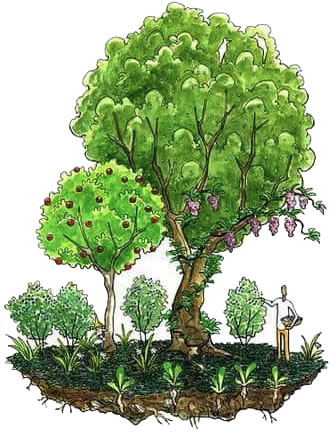What is a food forest ?
Food forests, also called forest gardens, mimic the diversity and development of natural forests.
A food forest is made up of different layers containing a wide variety of flora : trees, bushes, climbers and various edible or useful plants.
It rapidly becomes a resilient and productive ecosystem that requires little to no human intervention to water or maintain it.
Anyone can plant a food forest, in areas ranging from small gardens to waste ground, in cities or in deforested rural zones. It can also be planted around existing vegetation.
A syntropic food forest is a self-sustainable system that generates diversity and abundance.
Plants and trees are planted so that species cohabit and thrive, recreating the natural synergy with the soil, the air, birds and insects, and humans. A food forest is an invitation to participate in a symbiotic system of caring for one another.
Food forest layers

E.g. oak, chestnut, lime, olive
e.g. apple, hazel, cherry, elder, plum, fig, peach, persimmon
e.g. blackcurrant, blueberry, raspberry, goji.
e.g. lavender, oregano, rosemary, sorrel, cabbage, rocket
e.g. strawberry, mint, garlic
e.g. carrot, beet, dandelion, potato, radish, onions
e.g.: grapevine, bean, passionfruit, jasmin, kiwi, bramble, ivy
Mutually beneficial plants
Different species are grouped to encourage a symbiotic relationship with surrounding species. For example:
- Tall trees provide protection against the elements and produce leafmold that nourishes the soil
- Some plant fix nitrogen in the soil for other plants to thrive
- Some shrubs attract birds that eat slugs
- Some aromatics attract pollinators and discourage pests
- Some groundcover plants help store water in the ground longer
- Some root systems bring up nutrients from deeper to surface layers of soil to make them available to other plants
Planting is planned to organise shrubs, vegetables and other plants around trees, forming groups of plants called guilds. A guild associates plants that interact and support each other, creating a stable and resilient ecosystem. It is usually arranged around a central, taller plant, that is surrounded by various other species of companion plants.
Design and main steps
Creating a diverse and resilient food forest requires a plot of land of at least 100 sqm, away from dense traffic or sources of pollution (chemical plants etc) that could contaminate the forest’s leaves, roots or fruit. An urban area is ideal, since that is where an island of greenery will provide the most benefits.
It takes from three to five years for a forest to become established.
Year 1
- Soil preparation
Soil analysis and improvement (aerating, composting, adding manure and mulch). - Infrastructure:
Creating pathways, fences if required and meeting places. Building a toolshed and compost heap. Installing a watering system if required. - Communication:
Communicating with locals, town council, and forming a group of local volunteers - First stage of planting
Identifying native species adapted to local climate and soil. Planting young trees.
Year 2
- Second stage of planting
Planting plant guilds - Regular check
Watering adapted to weather conditions. Weeding and mulching around young plants. - First harvests
Occasions to share and celebrate
Year 3
- Potential third stage of planting
Replacing missing or inappropriate plants - Regular check
Watering adapted to weather conditions. Weeding and mulching around young plants. - General maintenance
Oiling and sharpening tools. Keeping pathways and steps safe and cleared. Pruning if required. - Artistic, cultural, educational, social, recreational and ecological activities and event.
Years 4 and 5
- Forest becomes self-sufficient. Little to no watering or maintenance is required.
- General maintenance
Oiling and sharpening tools. Keeping pathways and steps safe and cleared. Pruning if required. - Artistic, cultural, educational, social, recreational and ecological activities and events.